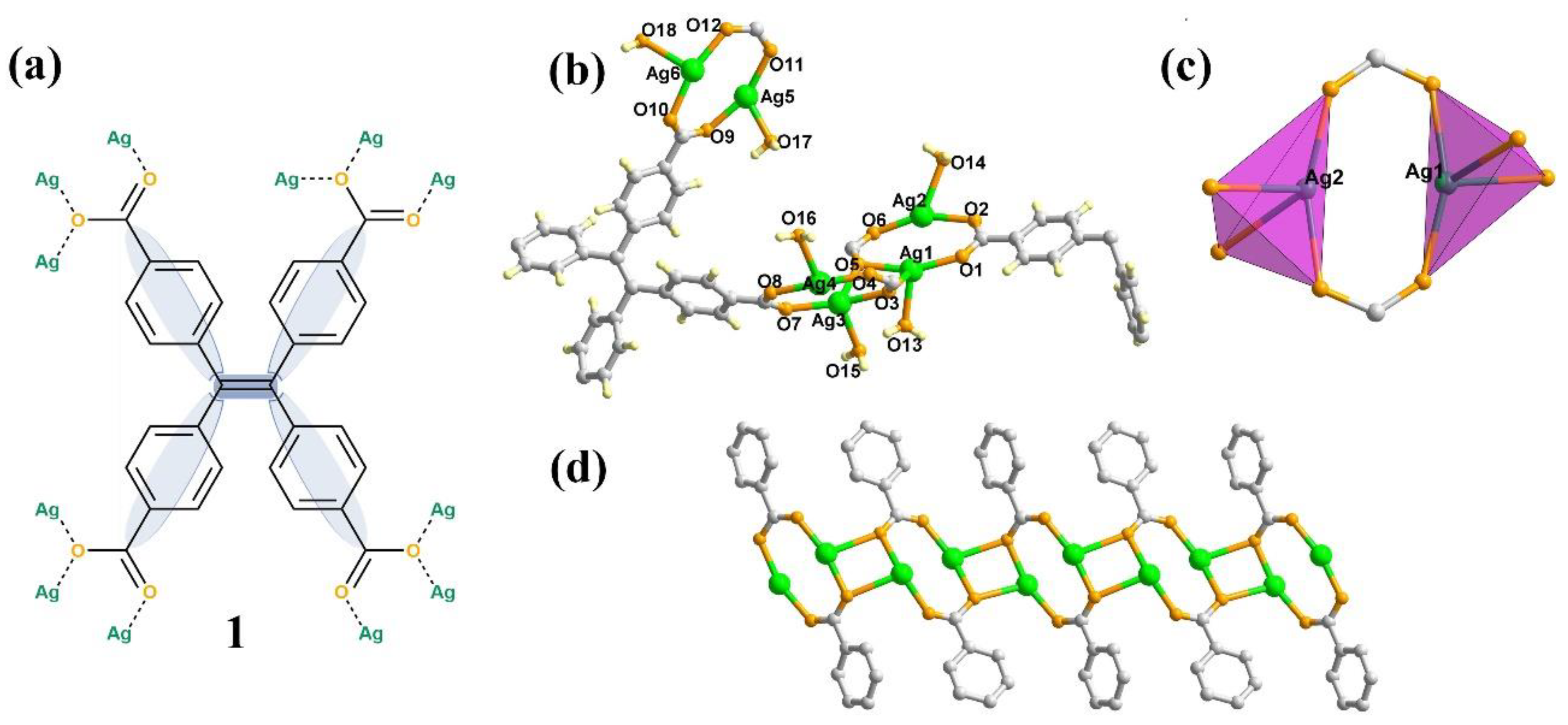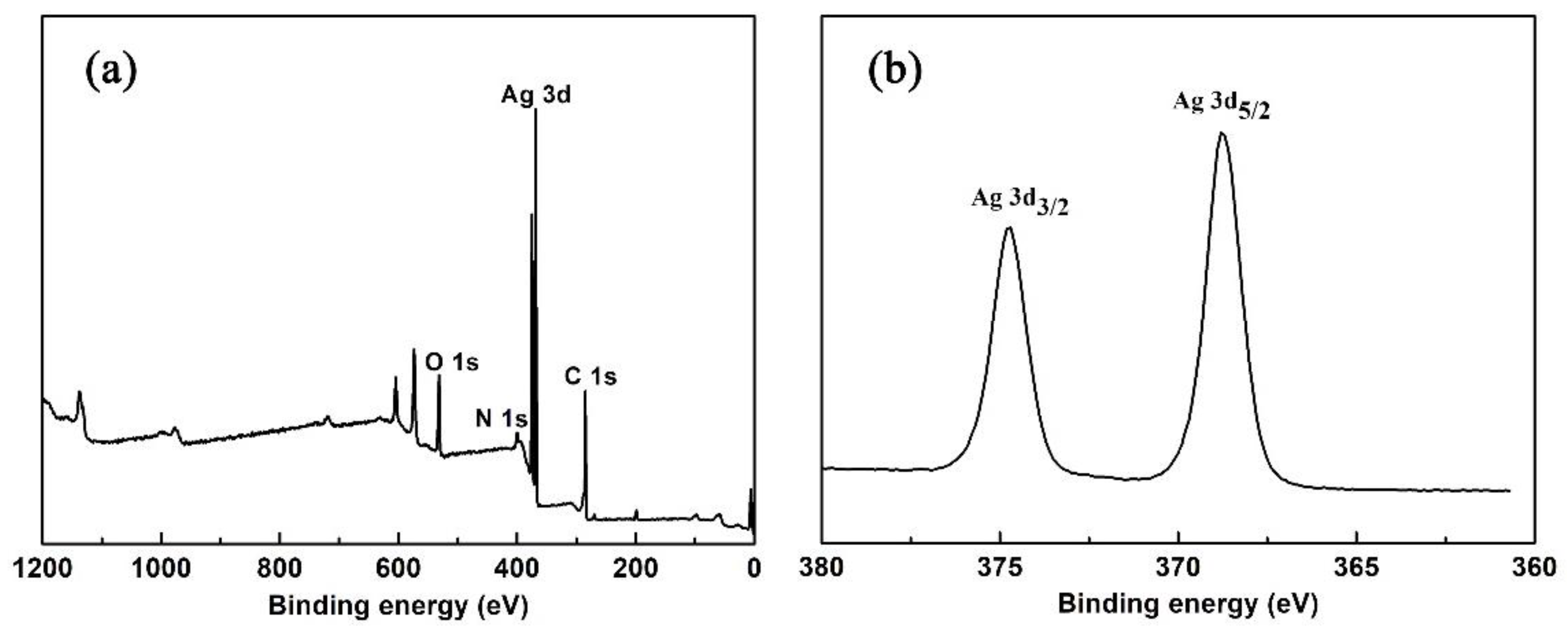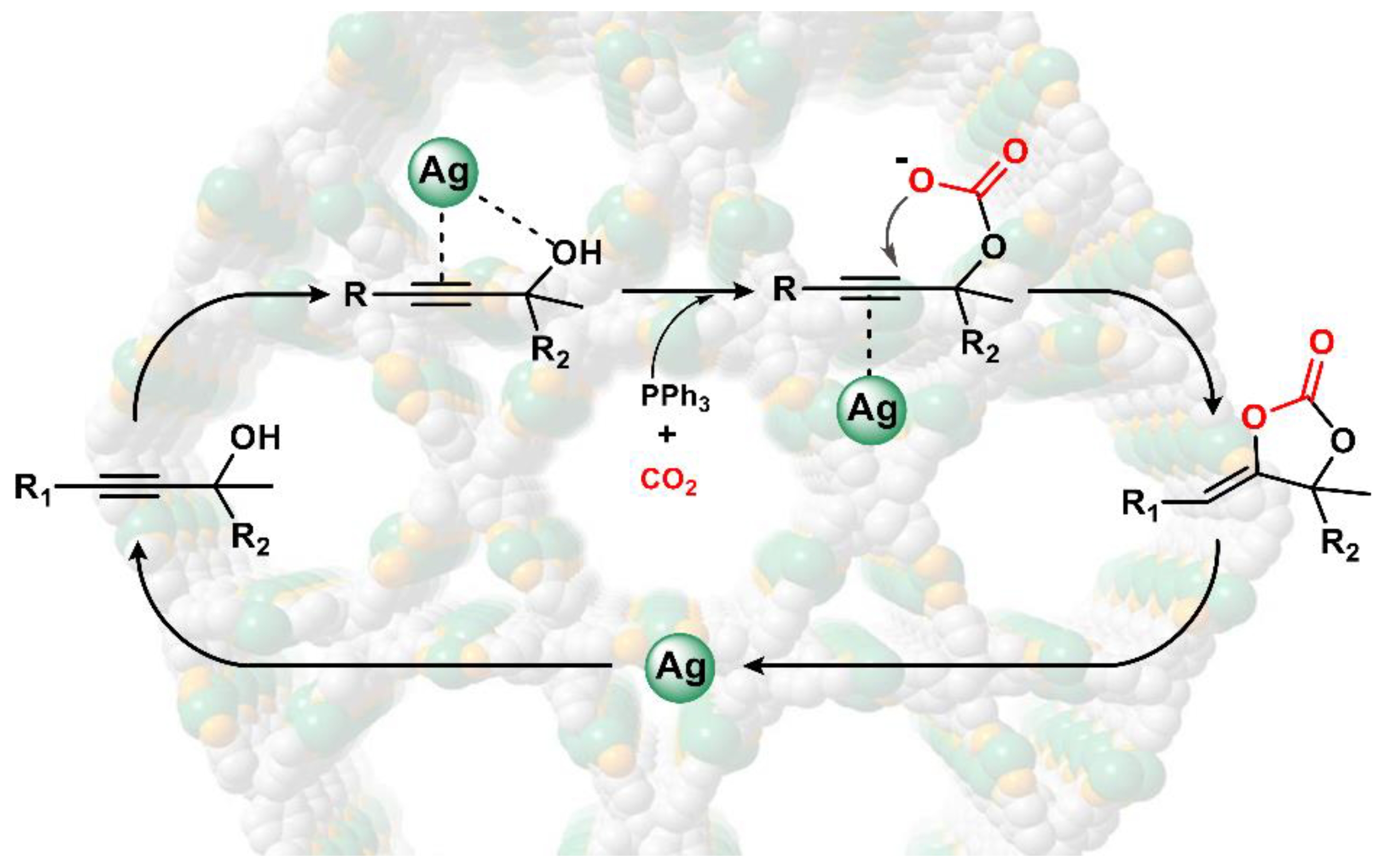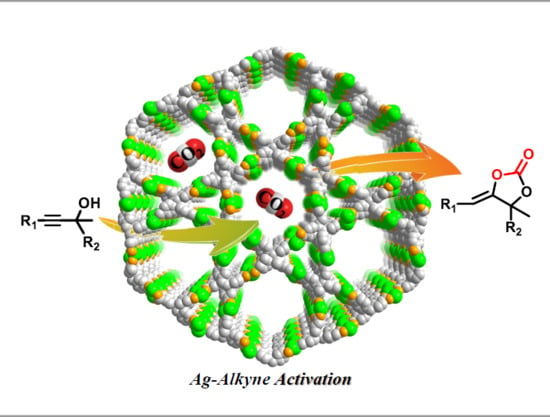A Versatile Porous Silver-Coordinated Material for the Heterogeneous Catalysis of Chemical Conversion with Propargylic Alcohols and CO2
Abstract
1. Introduction
2. Materials and Methods
2.1. General Experimental Details
2.2. Preparation of 1
2.3. Crystallography
2.4. Catalysis Experiments
3. Results and Discussion
3.1. Structure Description
3.2. XPS Analysis and CO2 Sorption Studies
3.3. Dye Adsorption Properties
3.4. Catalysis Studies
4. Conclusions
Supplementary Materials
Author Contributions
Funding
Conflicts of Interest
References
- Graciani, J.; Mudiyanselage, K.; Xu, F.; Baber, A.E.; Evans, J.; Senanayake, S.D.; Stacchiola, D.J.; Liu, P.; Hrbek, J.; Sanz, J.F.; et al. Highly active copper-ceria and copper-ceria-titania catalysts for methanol synthesis from CO2. Science 2014, 345, 546–550. [Google Scholar] [CrossRef] [PubMed]
- Cui, W.-G.; Zhang, G.-Y.; Hu, T.L.; Bu, X.-H. Metal-organic framework-based heterogeneous catalysts for the conversion of C1 chemistry: CO, CO2 and CH4. Coordin. Chem. Rev. 2019, 387, 79–120. [Google Scholar] [CrossRef]
- Kondratenko, E.V.; Mul, G.; Baltrusaitis, J.; Larrazábal, G.O.; Pérez-Ramírez, J. Status and perspectives of CO2 conversion into fuels and chemicals by catalytic, photocatalytic and electrocatalytic processes. Energy Environ. Sci. 2013, 6, 3112–3135. [Google Scholar] [CrossRef]
- Zhu, M.Q.; Carreon, M.A. Porous crystals as active catalysts for the synthesis of cyclic carbonates. J. Appl. Polym. Sci. 2014, 131, 39738. [Google Scholar] [CrossRef]
- Sneddon, G.; Greenaway, A.; Yiu, H.H.P. The potential applications of nanoporous materials for the adsorption, separation, and catalytic conversion of carbon dioxide. Adv. Energy Mater. 2014, 4, 1301873. [Google Scholar] [CrossRef]
- Beyzavi, M.H.; Stephenson, C.J.; Liu, Y.; Karagiaridi, O.; Hupp, J.T.; Farha, O.K. Metal-organic framework-based catalysts: Chemical fixation of CO2 with epoxides leading to cyclic organic carbonates. Front. Energy Res. 2015, 2, 63. [Google Scholar] [CrossRef]
- He, H.M.; Perman, J.A.; Zhu, G.S.; Ma, S.Q. Metal-organic frameworks for CO2 chemical transformations. Small 2016, 12, 6309–6324. [Google Scholar] [CrossRef]
- Zhou, Z.; Yang, L.; Wang, Y.F.; He, C.; Duan, C.Y. Recent advance on chemical fixation of carbon dioxide by metal-organic frameworks as heterogeneous catalysts. Curr. Org. Chem. 2018, 22, 1809–1824. [Google Scholar] [CrossRef]
- Li, B.; Wen, H.M.; Cui, Y.J.; Zhou, W.; Qian, G.D.; Chen, B.L. Emerging multifunctional metal-organic framework materials. Adv. Mater. 2016, 28, 8819–8860. [Google Scholar] [CrossRef]
- Liu, J.W.; Chen, L.F.; Cui, H.; Zhang, J.Y.; Zhang, L.; Su, C.Y. Applications of metal-organic frameworks in heterogeneous supramolecular catalysis. Chem. Soc. Rev. 2014, 43, 6011–6061. [Google Scholar] [CrossRef]
- Ding, M.L.; Flaig, R.W.; Jiang, H.-L.; Yaghi, O.M. Carbon capture and conversion using metal-organic frameworks and MOF-based materials. Chem. Soc. Rev. 2019, 48, 2783–2828. [Google Scholar] [CrossRef] [PubMed]
- Yang, L.; Zhang, D.P.; Yan, H.; Dong, Y.H.; Zhou, Z.; Wang, S.N. Flexible-ligand-based self-adaptive metal-organic material for supramolecular selective recognition of similar natural molecules. Inorg. Chem. 2019, 58, 4067–4070. [Google Scholar] [CrossRef] [PubMed]
- Maina, J.W.; Pozo-Gonzalo, C.; Kong, L.X.; Schütz, J.; Hillc, M.; Dumée, L.F. Metal organic framework based catalysts for CO2 conversion. Mater. Horiz. 2017, 4, 345–361. [Google Scholar] [CrossRef]
- Liang, J.; Huang, Y.-B.; Cao, R. Metal–organic frameworks and porous organic polymers for sustainable fixation of carbon dioxide into cyclic carbonates. Coordin. Chem. Rev. 2019, 378, 32–65. [Google Scholar] [CrossRef]
- Zhou, Z.; He, C.; Xiu, J.H.; Yang, L.; Duan, C.Y. Metal-organic polymers containing discrete single-walled nanotube as a heterogeneous catalyst for the cycloaddition of carbon dioxide to epoxides. J. Am. Chem. Soc. 2015, 137, 15066–15069. [Google Scholar] [CrossRef]
- Wang, Y.L.; Astruc, D.; Abd-El-Aziz, A.S. Metallopolymers for advanced sustainable applications. Chem. Soc. Rev. 2019, 48, 558–636. [Google Scholar] [CrossRef]
- Kumara, R.K.; Bi, X.H. Catalytic σ-activation of carbon-carbon triple bonds: Reactions of propargylic alcohols and alkynes. Chem. Commun. 2016, 52, 853–868. [Google Scholar] [CrossRef]
- Karmakara, R.; Lee, D. Reactions of arynes promoted by silver ions. Chem. Soc. Rev. 2016, 45, 4459–4470. [Google Scholar] [CrossRef]
- Fang, G.C.; Bi, X.H. Silver-catalysed reactions of alkynes: Recent advances. Chem. Soc. Rev. 2015, 44, 8124–8173. [Google Scholar] [CrossRef]
- Shen, T.; Wang, T.; Qin, C.; Jiao, N. Silver-catalyzed nitrogenation of alkynes: A direct approach to nitriles through C≡C bond cleavage. Angew. Chem. Int. Ed. 2013, 52, 6677–6680. [Google Scholar] [CrossRef]
- Sekine, K.; Yamada, T. Silver-catalyzed carboxylation. Chem. Soc. Rev. 2016, 45, 4524–4532. [Google Scholar] [CrossRef] [PubMed]
- Yang, Z.Z.; Yu, B.; Zhang, H.Y.; Zhao, Y.Y.; Chen, Y.; Ma, Z.S.; Ji, G.P.; Gao, X.; Han, B.X.; Liu, Z.M. Metalated mesoporous poly(triphenylphosphine) with azo functionality: Efficient catalysts for CO2 conversion. ACS Catal. 2016, 6, 1268–1273. [Google Scholar] [CrossRef]
- Gong, Y.Y.; Yuan, Y.; Chen, C.; Zhang, P.; Wang, J.C.; Zhuiykov, S.; Chaemchuen, S.; Verpoort, F. Core-shell metal-organic frameworks and metal functionalization to access highest efficiency in catalytic carboxylation. J. Catal. 2019, 371, 106–115. [Google Scholar] [CrossRef]
- Liu, X.H.; Ma, J.G.; Niu, Z.; Yang, G.M.; Cheng, P. An efficient nanoscale heterogeneous catalyst for the capture and conversion of carbon dioxide at ambient pressure. Angew. Chem. Int. Ed. 2015, 54, 988–991. [Google Scholar] [CrossRef] [PubMed]
- Zhou, Z.; He, C.; Yang, L.; Wang, Y.F.; Liu, T.; Duan, C.Y. Alkyne activation by a porous silver coordination polymer for heterogeneous catalysis of carbon dioxide cycloaddition. ACS Catal. 2017, 7, 2248–2256. [Google Scholar] [CrossRef]
- Shustova, N.B.; McCarthy, B.D.; Dincă, M. Turn-on fluorescence in tetraphenylethylene-based metal-organic frameworks: An alternative to aggregation-induced emission. J. Am. Chem. Soc. 2011, 133, 20126–20129. [Google Scholar] [CrossRef]
- SMART Data Collection Software (version 5.629); Bruker AXS Inc.: Madison, WI, USA, 2003.
- SAINT Data Reduction Software (version 6.45); Bruker AXS Inc.: Madison, WI, USA, 2003.
- Sheldrick, G.M. SHELXS-97, Program for Crystal Structure Solution; Göttingen University: Göttingen, Germany, 1997. [Google Scholar]
- Sheldrick, G.M. SHELXL-97. Program for Crystal Structure Refinement; Göttingen University: Göttingen, Germany, 1997. [Google Scholar]
- Feng, D.W.; Gu, Z.-Y.; Li, J.-R.; Jiang, H.-L.; Wei, Z.W.; Zhou, H.-C. Zirconium-metalloporphyrin PCN-222: Mesoporous metal-organic frameworks with ultrahigh stability as biomimetic catalysts. Angew. Chem. Int. Ed. 2012, 51, 10307–10310. [Google Scholar] [CrossRef]
- Mikhlin, Y.L.; Nasluzov, V.A.; Romanchenko, A.S.; Shor, A.M.; Pal’yanova, G.A. XPS and DFT studies of the electronic structures of AgAuS and Ag3AuS2. J. Alloy. Compd. 2014, 617, 314–321. [Google Scholar] [CrossRef]
- Yu, M.K.; Xie, Y.; Wang, X.Y.; Li, Y.X.; Li, G.M. Highly water-stable dye@Ln-MOFs for sensitive and selective detection toward antibiotics in water. ACS Appl. Mater. Interfaces. 2019, 11, 21201–21210. [Google Scholar] [CrossRef]
- He, J.C.; Li, J.; Du, W.; Han, Q.X.; Wang, Z.L.; Li, M.X. A mesoporous metal-organic framework: Potential advances in selective dye adsorption. J. Alloy. Compd. 2018, 750, 360–367. [Google Scholar] [CrossRef]
- Zhang, G.Y.; Yang, H.M.; Fei, H.H. Unusual missing linkers in an organosulfonate-based primitive-cubic (pcu)-type metal-organic framework for CO2 capture and conversion under ambient conditions. ACS Catal. 2018, 8, 2519–2525. [Google Scholar] [CrossRef]
- Song, Q.-W.; Chen, W.Q.; Ma, R.; Yu, A.; Li, Q.-Y.; Chang, Y.; He, L.-N. Bifunctional silver(I) complex-catalyzed CO2 conversion at ambient conditions: Synthesis of α-methylene cyclic carbonates and derivatives. ChemSusChem 2015, 8, 821–827. [Google Scholar] [CrossRef] [PubMed]







| Compound | 1 |
|---|---|
| Empirical formula | C90H54Ag12O27 |
| Formula weight | 2861.77 |
| T/K | 200(2) |
| Crystal system | Monoclinic |
| Space group | C 2/c |
| a/Å | 31.9216(11) |
| b/Å | 56.6381(18) |
| c/Å | 11.0729(4) |
| α/o | 90 |
| β/o | 97.905(2) |
| γ/o | 90 |
| V/Å3 | 19829.3(12) |
| Z | 4 |
| Dcalc/Mg m–3 | 0.959 |
| µ/mm–1 | 1.191 |
| F(000) | 5496 |
| Rint | 0.1206 |
| Data/parameters | 17,459/672 |
| GOF | 1.052 |
| R [I > 2σ(I)] a | R1 = 0.0747 wR2 = 0.2088 |
| R indices (all data) b | R1 = 0.1357 wR2 = 0.2376 |
| Δρmax,min/eÅ–3 | 1.444/−0.783 |
| CCDC number | 1918824 |

| Entry | R1 | R2 | Yield | TON |
|---|---|---|---|---|
| 1 | H | H | 97% | 320 |
| 2 | Me | H | 94% | 310 |
| 3 | Et | H | 93% | 310 |
| 4 | n-Pr | H | 91% | 300 |
| 5 | t-Bu | H | 78% | 260 |
| 6 | Cl | H | >99% | 330 |
| 7 | MeO | H | 97% | 320 |
| 8 | H | Ph | 28% | 90 |
© 2019 by the authors. Licensee MDPI, Basel, Switzerland. This article is an open access article distributed under the terms and conditions of the Creative Commons Attribution (CC BY) license (http://creativecommons.org/licenses/by/4.0/).
Share and Cite
Yang, L.; Dou, Y.; Zhou, Z.; Zhang, D.; Wang, S. A Versatile Porous Silver-Coordinated Material for the Heterogeneous Catalysis of Chemical Conversion with Propargylic Alcohols and CO2. Nanomaterials 2019, 9, 1566. https://doi.org/10.3390/nano9111566
Yang L, Dou Y, Zhou Z, Zhang D, Wang S. A Versatile Porous Silver-Coordinated Material for the Heterogeneous Catalysis of Chemical Conversion with Propargylic Alcohols and CO2. Nanomaterials. 2019; 9(11):1566. https://doi.org/10.3390/nano9111566
Chicago/Turabian StyleYang, Lu, Yong Dou, Zhen Zhou, Daopeng Zhang, and Suna Wang. 2019. "A Versatile Porous Silver-Coordinated Material for the Heterogeneous Catalysis of Chemical Conversion with Propargylic Alcohols and CO2" Nanomaterials 9, no. 11: 1566. https://doi.org/10.3390/nano9111566
APA StyleYang, L., Dou, Y., Zhou, Z., Zhang, D., & Wang, S. (2019). A Versatile Porous Silver-Coordinated Material for the Heterogeneous Catalysis of Chemical Conversion with Propargylic Alcohols and CO2. Nanomaterials, 9(11), 1566. https://doi.org/10.3390/nano9111566






